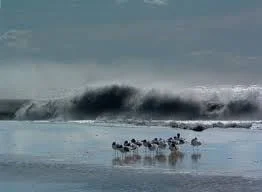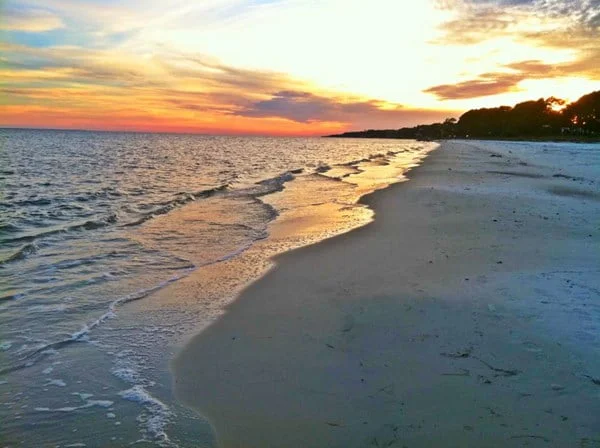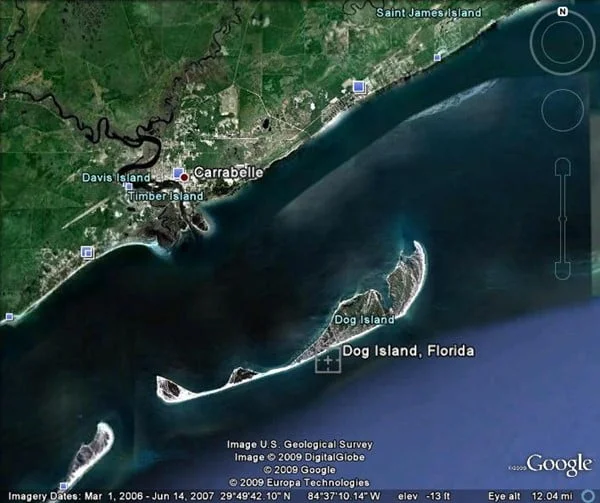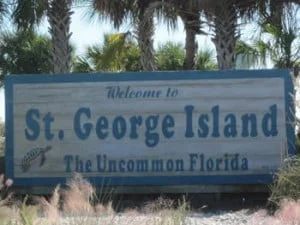Beaches
Here you will find many miles of beautiful white “sugar sand” beaches for walking, swimming, sunning, surf fishing, bird watching or simply indulging your need for relaxation and tranquility.
The county installed the beach warning flag system in 2012 at the public beaches and a sign explaining what the flags mean. The beach warning flag alerts swimmers to the daily rip tide conditions. For current beach conditions you can go to Oyster Radio’s website: www.oysterradio.com/ Please bookmark this as a valuable tool to have to identify current beach conditions/warnings before entering the waters. In addition, there is now also a new Beach Warning Flag located as you come onto St. George Island, just off the exit of the bridge and near the restrooms at Carrabelle Beach. Green flag means the risk is low – red means high risk. Double red flag means the water is closed to public use. Purple means marine pests in water, ex: jellyfish. The Parks and Recreation clean-up crew are in charge of changing the flags every day. It is important that swimmers know the beach conditions before jumping into the Gulf.
Part of our “beach charm” is sharing with all the plants & wildlife such as turtles, birds, dolphins. Together residents and visitors can ensure our beaches are healthy and safe places for everyone for years to come, so help keep it tidy, leave the beach cleaner than you found it. Check to make sure a shell is empty before taking it. The creature that made it may still be alive inside! If birds fly off when you walk by, you are too close. Please observe all posted signs to protected areas.
Here’s a few tips for dogs on our beaches:
- Your four-legged friend must be leashed at all times – so be sure to bring a long leash!
- Don’t leave a mess behind…just footprints! Don’t count on the beach supplying waste bags, so bring your own and be diligent about cleaning up.
- Do check the ocean for jellyfish and stingrays. A sting to your dog will be sure to ruin both his and your experience.
- Be aware of the heat of the sand and paved areas so delicate paws will not get burned! May also want to consider sunscreen for your pet, they get sunburned too!
- Stay our of posted Critical Wildlife Areas, listed on MyFWC.com/CWA.
- Keep out of roped or flagged beach areas, even if you don’t see any wildlife.
- Keep your dog as far away from wildlife as possible. Do not allow dog to disturb or chase birds or dig holes, which could damage turtle nests or trap hatchlings.
- Make sure your dog stays out of the dunes to avoid disturbance of beach mouse habitat.
- Avoid walking your dog on the beach at night during the March-October sea turtle nesting season.
- In accordance with Americans with Disabilities Act Title III regulations, disabled individuals are allowed to be accompanied by service dogs on any beach open to the public. Emotional support animals, comfort animals and therapy dogs are not considered service animals under Title II or Title III of the ADA and therefore are not permitted on beaches that are closed to pets. A service dog must remain under the owner’s control at all times. Any individual whose failure to maintain control of a dog results in disturbance to wildlife will be asked to leave the beach and may receive a citation.
- Spread the word about being a wildlife-friendly dog owner on the beach!
- If you see dogs disturbing wildlife, report it to the FWC’s Wildlife Alert Hotline: (888) 404-3922, # FWC or *FWC on a cell phone, or by texting Tip@MyFWC.com.
Enjoy a 25 minute video filmed in 2012 that will give you a tour of Franklin County’s Top Beaches.





